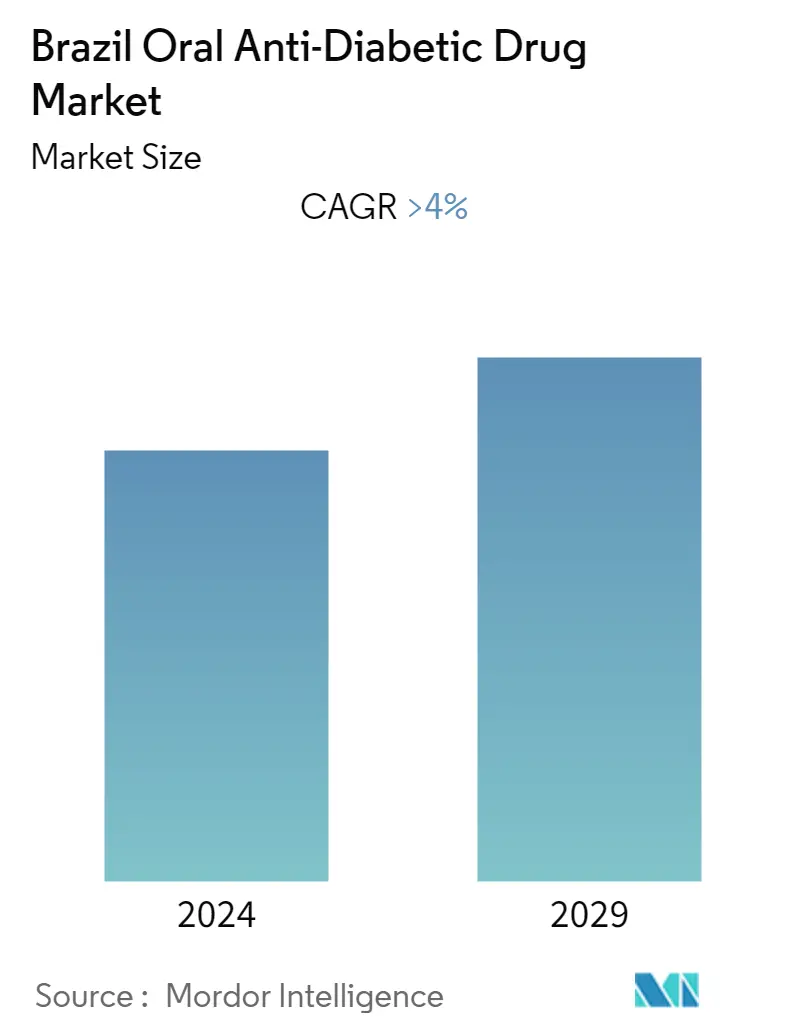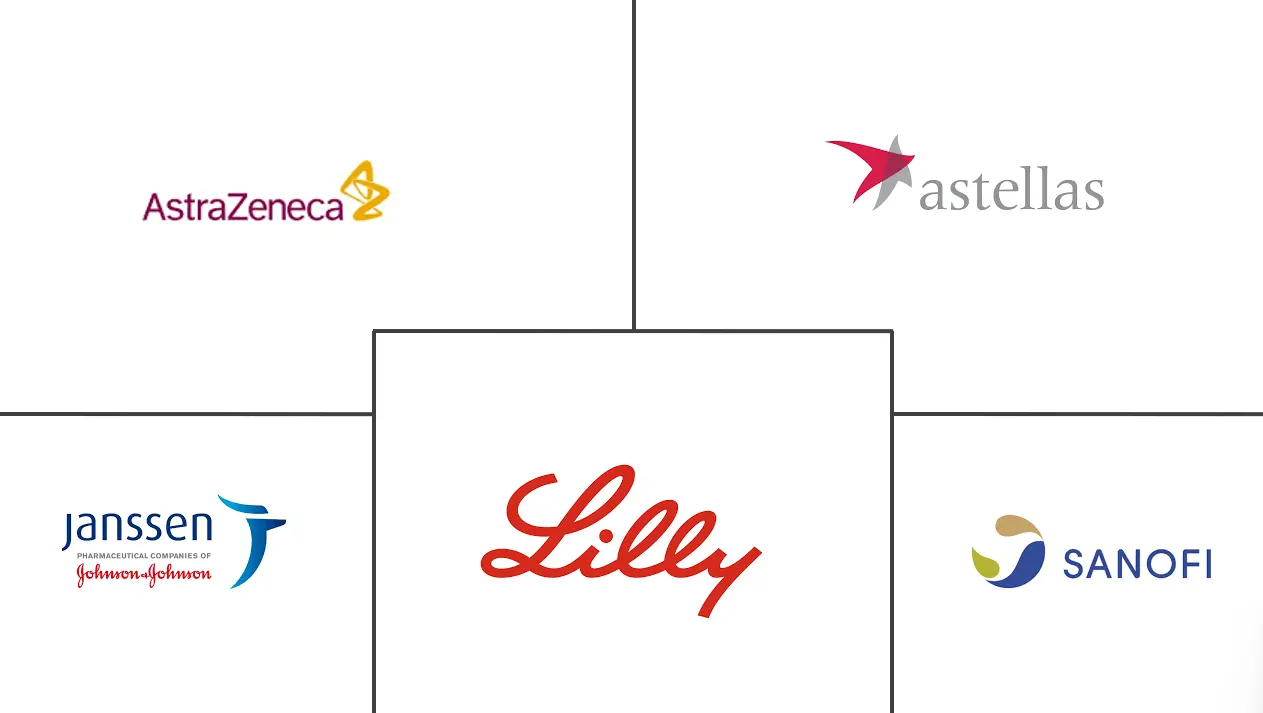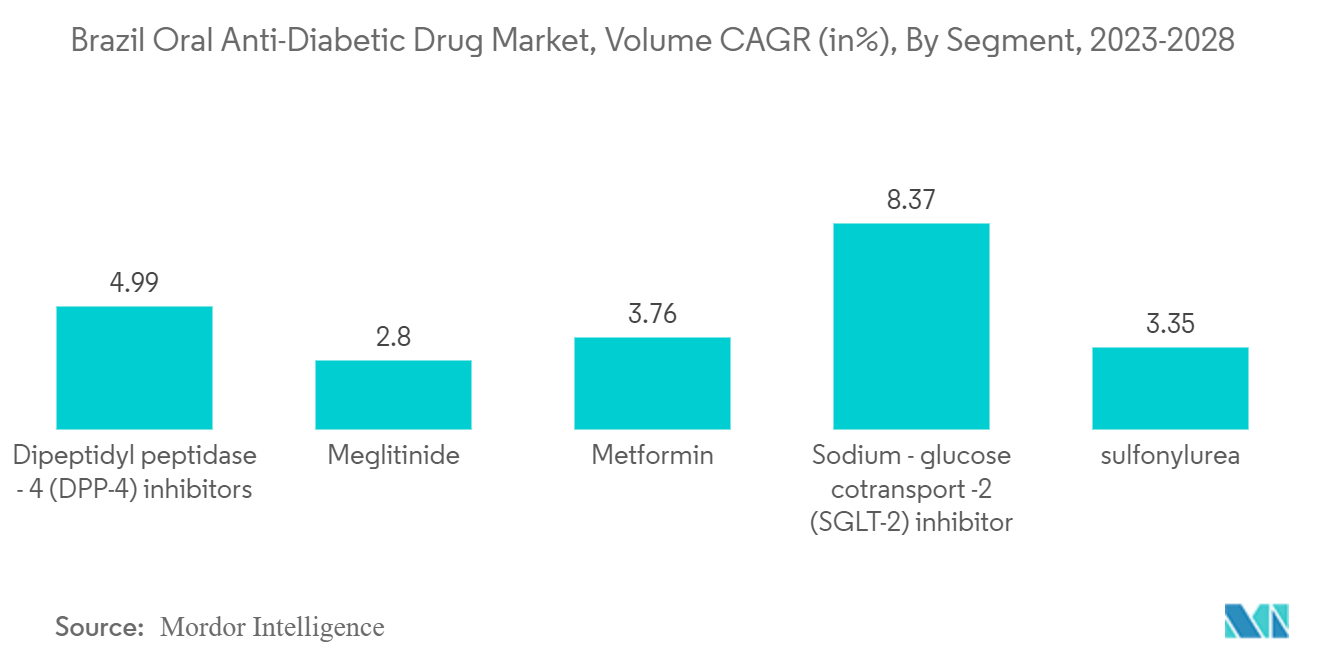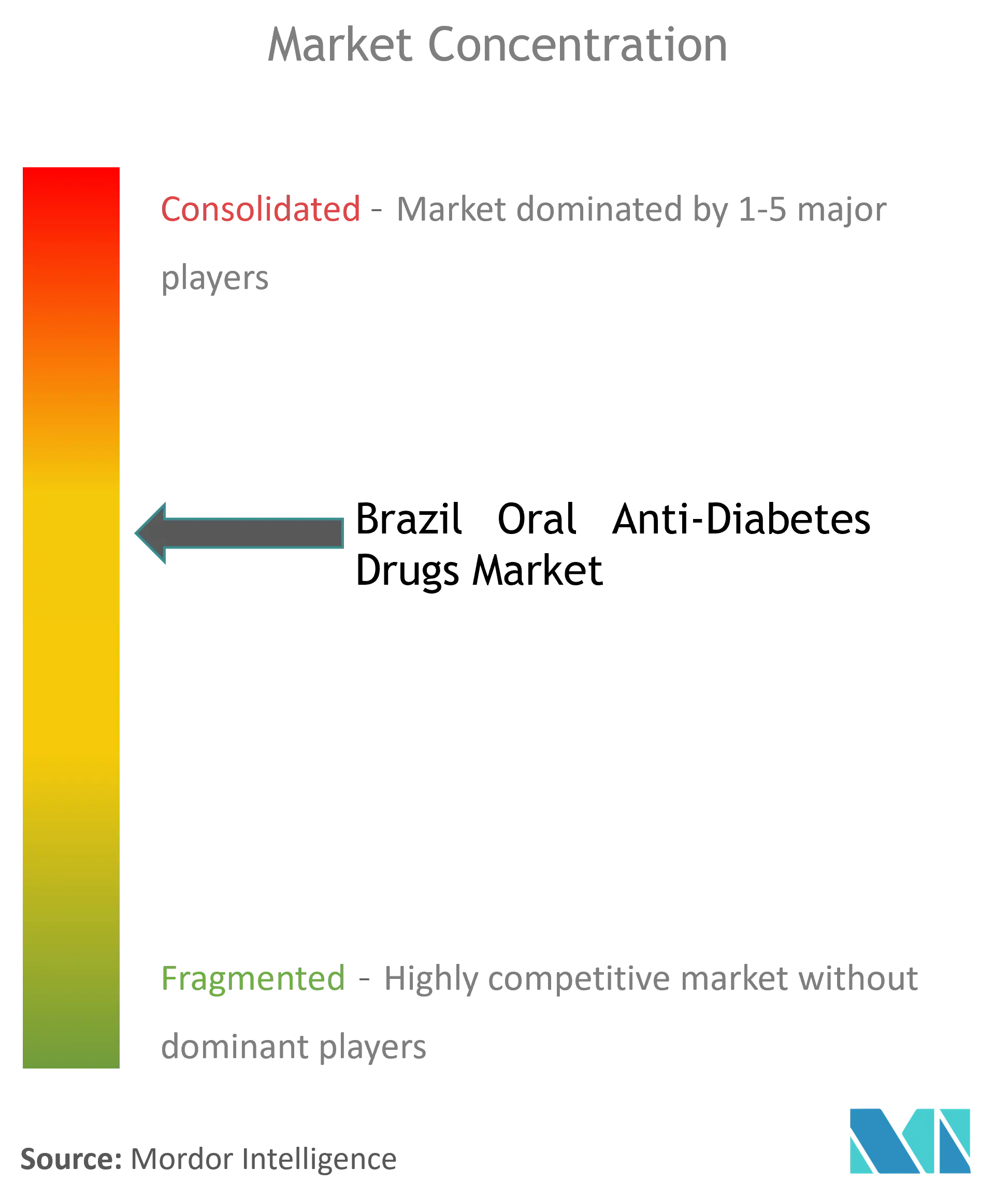Brazil Oral Anti-Diabetic Drug Market Size

| Study Period | 2019 - 2029 |
| Base Year For Estimation | 2023 |
| Forecast Data Period | 2024 - 2029 |
| Historical Data Period | 2019 - 2022 |
| CAGR | > 4.00 % |
Major Players
*Disclaimer: Major Players sorted in no particular order |
Brazil Oral Anti-Diabetic Drug Market Analysis
The Brazil Oral Anti-Diabetic Drug Market is expected to register a CAGR of more than 4% during the forecast period, with revenue of USD 861 million in the current year.
The COVID-19 pandemic caused early fatalities during the first year of its existence, primarily in older people. Most COVID-19 deaths were caused by co-existing two or more chronic diseases in the same person. Numerous studies established the link between long-term conditions, including diabetes, and unfavorable outcomes in COVID-19 patients. Compared to healthy persons, those with diabetes were more likely to experience significant complications. During COVID-19, the makers of diabetes pharmaceuticals took special care to ensure that diabetic patients received their meds with the assistance of local governments. Drugs known as diabetic medications were created to stabilize and regulate blood glucose levels in people with diabetes. Diabetes patients infected with SARS-CoV-2 during the COVID-19 pandemic may be treated with diabetic medications. The relevance of diabetes treatment medications has been highlighted by the high incidence of diabetes among those hospitalized with COVID-19 infection and the realization that better glycemic management may improve outcomes and shorten hospital stays in COVID-19 patients.
One in ten Brazilian people, or 15.7 million individuals, or roughly 10.5% of the population, have diabetes, according to the IDF Diabetes Atlas 2021. Brazil has the third-highest global diabetes-related health expenditure, costing 42.9 billion USD. Additionally, 18.9% of adults, or 18 million people, have impaired glucose tolerance, which puts them at a greater risk of becoming type 2 diabetes. In Brazil, 32% of people with diabetes are not diagnosed. Only 25% of Brazilians, according to further data on glycaemic management, achieved the treatment target of having an HbA1c of less than 7% before the pandemic, as advised by the Brazilian Diabetes Society (SBD).
Diabetes patients risk significant and even fatal consequences like heart attack, stroke, kidney failure, blindness, and lower limb amputation when undiagnosed or not appropriately controlled. These hurt the quality of life, increase healthcare spending, and make access to treatment more critical. To combat risk factors like obesity and emerging pandemic threats, Brazil has implemented several reforms over the years to improve the distribution of doctors, create new types of service organizations, introduce new financing models, and implement various quality improvement initiatives and policy frameworks. This also shows areas where improvements in how diabetes treatment is provided may be expanded and continued.
Brazil Oral Anti-Diabetic Drug Market Trends
Sulfonylurea Segment Occupied the Highest Market Share in the Brazil Oral Anti-Diabetic Drugs Market in the current year.
Regarding revenue, the sulfonylurea segment is anticipated to lead the Brazil Oral Anti-Diabetic Drugs Market and post a CAGR of over 1% during the forecast year.
Sulfonylureas reduce glycated hemoglobin A1C (HbA1c) by 1% to 1.25% and have comparable effectiveness. Due to their low cost, second-generation sulfonylureas are among the most popular anti-diabetic drugs. Today, doctors seldom ever recommend first-generation sulfonylureas. Sulfonylureas are not recommended for older individuals and those with renal or hepatic impairment. Sulfonylureas can be used with any other oral diabetes medicine, except meglitinides (nateglinide and repaglinide), for Type 2 diabetes patients. to take anti-diabetic drugs to manage their blood sugar levels and prevent hypo and hyperglycemia. Oral anti-diabetic medications have higher acceptability than insulin, improving therapy adherence. They also have the advantages of easier control and cheaper cost. IDF asserts that several socioeconomic, demographic, environmental, and genetic factors, including urbanization, aging populations, declining levels of physical activity, and rising rates of overweight and obesity, are to blame for Brazil's Type 2 diabetes epidemic. In Brazil, diabetes is becoming more common among people of all ages. Due to its high incidence and associated rising cost burdens on individuals, healthcare systems, and governments, diabetes mellitus has drawn a lot of attention. The Brazilian government's many measures are anticipated to fuel the market's expansion. The government has cooperated with various private businesses to use its supply chain (production, distribution, and merchants) to guarantee affordable medicine pricing.
Sulfonylureas reduce glycated hemoglobin A1C (HbA1c) by 1% to 1.25% and have comparable effectiveness. Due to their low cost, second-generation sulfonylureas are among the most popular anti-diabetic drugs. Today, doctors seldom ever recommend first-generation sulfonylureas. Sulfonylureas are not recommended for older individuals and those with renal or hepatic impairment. Sulfonylureas can be used with any other oral diabetes medicine, except meglitinides (nateglinide and repaglinide), for type 2 diabetes patients. Therefore, the abovementioned factors are anticipated to expand the category during the forecast period.

The increasing Diabetes Population in Brazil is driving the market.
Diabetes is a severe health issue that presents one of the most incredible difficulties to Brazilian healthcare systems. The development of novel medications to provide diabetic patients with more treatment choices has been driven by the disease's increasing incidence, prevalence, and progressive nature. Some of the key prospects for the participants in the diabetes medications market include the introduction of several new products, expanding international research partnerships for technological progress, and raising public awareness of diabetes. The Brazilian government's many measures are anticipated to fuel the market's expansion. To ensure affordable medicine pricing, the Brazilian Federal Government collaborated with various private businesses to use their supply chain (production, distribution, and retailing).
The level of support for people with diabetes has been steadily rising under Brazil's public health system (Sistema nico de Sade; SUS). In Brazil, SUS continued to be the primary source for obtaining oral antidiabetic medications, funding more than 70% of them in the nation when taking into account Health Unit Pharmacies and Popular Pharmacies, demonstrating the significance of public pharmaceutical policies in ensuring the Brazilian population's access to medications and in lowering inequities in the nation. However, consumers' shift from SUS Health Units to Popular Pharmacies shows that Primary Health treatment's role in administering oral antidiabetic medications may be lessened, damaging the relationship and the continuity of treatment. The health system has to be reorganized due to the rise in chronic illnesses, which calls for investments in research, surveillance, NCD prevention, and promoting healthy lifestyles. The Brazilian Ministry of Health published the Strategic Action Plan to Tackle NCDs in Brazil, 2011-2022, which calls for expanding free access to medications and other health products. It also aims to monitor access to essential health services, including medicine, as a crucial part of NCD surveillance.
Therefore, the abovementioned factors are anticipated to expand the category during the forecast period.

Brazil Oral Anti-Diabetic Drug Industry Overview
The Oral Anti-Diabetic Drug Market is consolidated, with a few major manufacturers like Eli Lilly, AstraZeneca, Sanofi, and Janssen Pharmaceuticals having a global market presence. In contrast, the remaining manufacturers are confined to the other local or regional markets. Companies are focusing on innovations in diabetes drugs.
Brazil Oral Anti-Diabetic Drug Market Leaders
-
Astrazeneca
-
Astellas
-
Janssen
-
Eli Lilly
-
Sanofi
*Disclaimer: Major Players sorted in no particular order

Brazil Oral Anti-Diabetic Drug Market News
- March 2022: Oramed announced that ORMD-0801 (a new molecule) is being evaluated in two pivotal Phase 3 trials and can be the first oral insulin capsule with the most convenient and safest way to deliver insulin therapy. This drug is expected to be a game-changer in the insulin and oral anti-diabetes drugs markets.
- February 2022: Eurofarma launched Suganon (evogliptin) in Latin America, an innovative therapy for Type 2 diabetes patients. Suganon (evogliptin) is a new DPP-4 enzyme inhibitor, which features the benefits of offering convenient dosing and having a low potential for interaction with other medications, ensuring greater ease and safety for prescribers and Type 2 diabetes patients.
Table of Contents
1. INTRODUCTION
1.1 Study Assumptions and Market Definition
1.2 Scope of the Study
2. RESEARCH METHODOLOGY
3. EXECUTIVE SUMMARY
4. MARKET DYNAMICS
4.1 Market Overview
4.2 Market Drivers
4.3 Market Restraints
4.4 Porter's Five Forces Analysis
4.4.1 Bargaining Power of Suppliers
4.4.2 Bargaining Power of Consumers
4.4.3 Threat of New Entrants
4.4.4 Threat of Substitute Products and Services
4.4.5 Intensity of Competitive Rivalry
5. MARKET SEGMENTATION
5.1 Oral Anti-diabetic drugs
5.1.1 Biguanides
5.1.1.1 Metformin
5.1.2 Alpha-Glucosidase Inhibitors
5.1.2.1 Alpha-Glucosidase Inhibitors
5.1.3 Dopamine D2 receptor agonist
5.1.3.1 Bromocriptin
5.1.4 SGLT-2 inhibitors
5.1.4.1 Invokana (Canagliflozin)
5.1.4.2 Jardiance (Empagliflozin)
5.1.4.3 Farxiga/Forxiga (Dapagliflozin)
5.1.4.4 Suglat (Ipragliflozin)
5.1.5 DPP-4 inhibitors
5.1.5.1 Onglyza (Saxagliptin)
5.1.5.2 Tradjenta (Linagliptin)
5.1.5.3 Vipidia/Nesina(Alogliptin)
5.1.5.4 Galvus (Vildagliptin)
5.1.6 Sulfonylureas
5.1.6.1 Sulfonylureas
5.1.7 Meglitinides
5.1.7.1 Meglitinides
6. MARKET INDICATORS
6.1 Type-1 Diabetic Population
6.2 Type-2 Diabetic Population
7. COMPETITIVE LANDSCAPE
7.1 COMPANY PROFILES
7.1.1 Takeda
7.1.2 Novo Nordisk
7.1.3 Pfizer
7.1.4 Eli Lilly
7.1.5 Janssen Pharmaceuticals
7.1.6 Astellas
7.1.7 Boehringer Ingelheim
7.1.8 Merck And Co.
7.1.9 AstraZeneca
7.1.10 Bristol Myers Squibb
7.1.11 Novartis
7.1.12 Sanofi
- *List Not Exhaustive
8. MARKET OPPORTUNITIES AND FUTURE TRENDS
Brazil Oral Anti-Diabetic Drug Industry Segmentation
Orally administered antihyperglycemic drugs reduce blood glucose levels. They are often used in type 2 diabetes care. Brazil's Oral Anti-Diabetic Drug Market is set to witness a CAGR of more than 4% during the forecast period. Brazil Oral Anti-Diabetic Drug Market is segmented into drugs (Biguanides, Alpha-glucosidase inhibitors, Dopamine-D2 receptor agonists, Sodium-glucose Cotransport-2 (SGLT-2) inhibitor, Dipeptidyl Peptidase-4 (DPP-4) Inhibitors, Sulfonylureas, and Meglitinides). The report offers the value (in USD million) and volume (in Units million) for the above segments.
| Oral Anti-diabetic drugs | ||||||
| ||||||
| ||||||
| ||||||
| ||||||
| ||||||
| ||||||
|
Frequently Asked Questions
What is the current Brazil Oral Anti-Diabetic Drug Market size?
The Brazil Oral Anti-Diabetic Drug Market is projected to register a CAGR of greater than 4% during the forecast period (2024-2029)
Who are the key players in Brazil Oral Anti-Diabetic Drug Market?
Astrazeneca, Astellas, Janssen, Eli Lilly and Sanofi are the major companies operating in the Brazil Oral Anti-Diabetic Drug Market.
What years does this Brazil Oral Anti-Diabetic Drug Market cover?
The report covers the Brazil Oral Anti-Diabetic Drug Market historical market size for years: 2019, 2020, 2021, 2022 and 2023. The report also forecasts the Brazil Oral Anti-Diabetic Drug Market size for years: 2024, 2025, 2026, 2027, 2028 and 2029.
Brazil Oral Anti-Diabetic Drug Industry Report
Statistics for the 2024 Brazil Oral Anti-Diabetic Drug market share, size and revenue growth rate, created by Mordor Intelligence™ Industry Reports. Brazil Oral Anti-Diabetic Drug analysis includes a market forecast outlook to for 2024 to 2029 and historical overview. Get a sample of this industry analysis as a free report PDF download.



